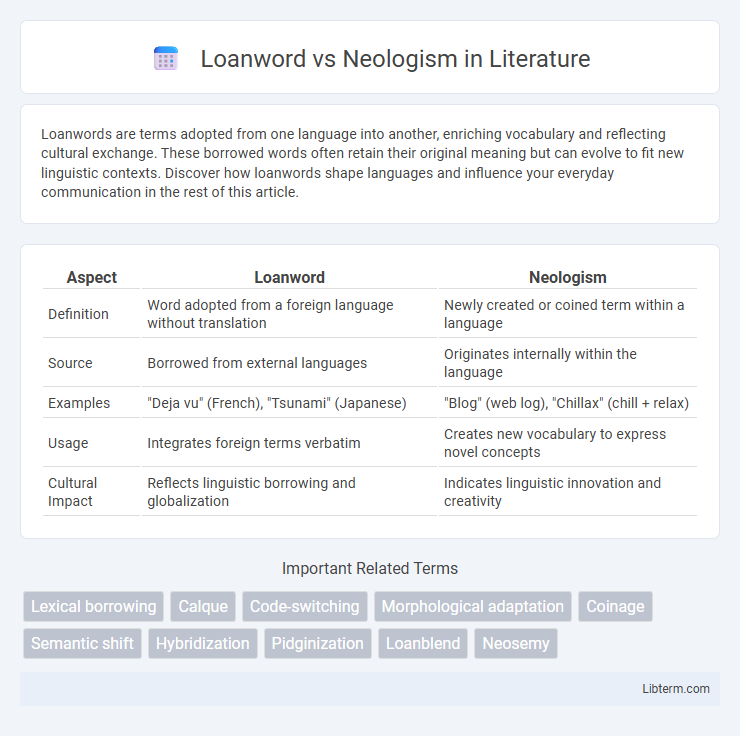Loanwords are terms adopted from one language into another, enriching vocabulary and reflecting cultural exchange. These borrowed words often retain their original meaning but can evolve to fit new linguistic contexts. Discover how loanwords shape languages and influence your everyday communication in the rest of this article.
Table of Comparison
| Aspect | Loanword | Neologism |
|---|---|---|
| Definition | Word adopted from a foreign language without translation | Newly created or coined term within a language |
| Source | Borrowed from external languages | Originates internally within the language |
| Examples | "Deja vu" (French), "Tsunami" (Japanese) | "Blog" (web log), "Chillax" (chill + relax) |
| Usage | Integrates foreign terms verbatim | Creates new vocabulary to express novel concepts |
| Cultural Impact | Reflects linguistic borrowing and globalization | Indicates linguistic innovation and creativity |
Introduction to Loanwords and Neologisms
Loanwords are borrowed terms from one language incorporated into another, enriching vocabulary with foreign expressions like "ballet" from French or "karaoke" from Japanese. Neologisms are newly coined words or phrases created to describe emerging concepts or phenomena, such as "selfie" or "blog." Both loanwords and neologisms demonstrate the dynamic nature of language evolution and cultural exchange.
Defining Loanwords: Origins and Characteristics
Loanwords are terms adopted from one language into another without translation, reflecting cultural and linguistic exchange, often retaining their original pronunciation and meaning. These borrowed words typically arise from historical contact such as trade, colonization, or globalization, incorporating foreign lexical items into the recipient language's vocabulary. Loanwords contrast with neologisms, which are newly created or coined terms, highlighting the impact of external influence versus internal linguistic innovation.
What Are Neologisms? Meaning and Evolution
Neologisms are newly coined words or expressions that emerge to describe novel concepts, inventions, or cultural phenomena, constantly enriching the lexicon. Unlike loanwords borrowed from other languages, neologisms originate within the language itself or evolve through creative morphological processes, reflecting ongoing linguistic innovation. Their meaning and usage evolve rapidly, influenced by social trends, technology, and media, shaping how language adapts to contemporary communication needs.
Historical Overview: Borrowing vs. Inventing Words
Loanwords have historically emerged through cultural contact, trade, and conquest, as languages borrowed terms to fill lexical gaps or introduce foreign concepts, exemplified by English adopting "ballet" from French and "ketchup" from Chinese. Neologisms arise from internal language innovation, often driven by technological advances or social changes, creating new words like "internet" or "selfie" to describe novel phenomena. Distinguishing borrowing from inventing reflects how languages balance external influence and internal creativity across time.
Mechanisms of Loanword Adoption
Loanword adoption involves the integration of foreign terms into a language's lexicon through direct borrowing, often to fill lexical gaps or introduce new concepts, influenced by cultural contact and trade. Phonological and morphological adjustments occur to conform loanwords to the recipient language's sound system and grammatical structure, facilitating their naturalization. Unlike neologisms that are newly created within the language, loanwords originate externally, reflecting historical and social interactions between language communities.
Creation and Spread of Neologisms
Neologisms emerge through processes such as compounding, blending, and borrowing, reflecting cultural and technological innovations. Unlike loanwords, which are directly adopted from other languages, neologisms often gain traction within specific communities before spreading widely through media and social platforms. Their adoption is accelerated by globalization and digital communication, driving rapid changes in language use.
Impact on Language Structure and Vocabulary
Loanwords introduce foreign vocabulary directly, often enriching a language with terms for new concepts, technologies, or cultural practices, while sometimes altering phonology and morphology to fit native patterns. Neologisms emerge organically within a language, reflecting innovation and shifts in society, frequently expanding morphological productivity through compounding or affixation. Both processes reshape vocabulary and influence syntactic and lexical norms, but loanwords can cause more abrupt structural adaptations due to their external origins.
Cultural Influences on Loanword and Neologism Usage
Loanwords often emerge from direct cultural contact, reflecting the borrowing society's need to incorporate new concepts, objects, or practices from another culture, such as "sushi" from Japanese into English. Neologisms, on the other hand, frequently arise internally within a culture to express novel ideas, technological advances, or social changes, exemplified by terms like "selfie" or "blog." Cultural influences shape the preference for loanwords or neologisms depending on the degree of exposure, adaptation willingness, and linguistic innovation within a speech community.
Controversies and Debates: Purity vs. Innovation
Loanwords often spark debates about language purity, as critics argue they dilute native vocabulary and cultural identity, while proponents see them as enriching linguistic diversity. Neologisms face scrutiny for either preserving language vitality through innovation or disrupting traditional grammar and semantics. The tension between maintaining a pure language and embracing linguistic evolution reflects broader cultural and ideological conflicts.
Conclusion: The Dynamic Nature of Language
Loanwords and neologisms illustrate the dynamic nature of language, reflecting continual adaptation to cultural and technological changes. Loanwords integrate foreign terms into a language, enriching vocabulary through cross-cultural exchange, while neologisms emerge from the creation of new concepts or innovations. This ongoing process demonstrates language's flexibility and its role as a living, evolving system responding to societal shifts.
Loanword Infographic

 libterm.com
libterm.com